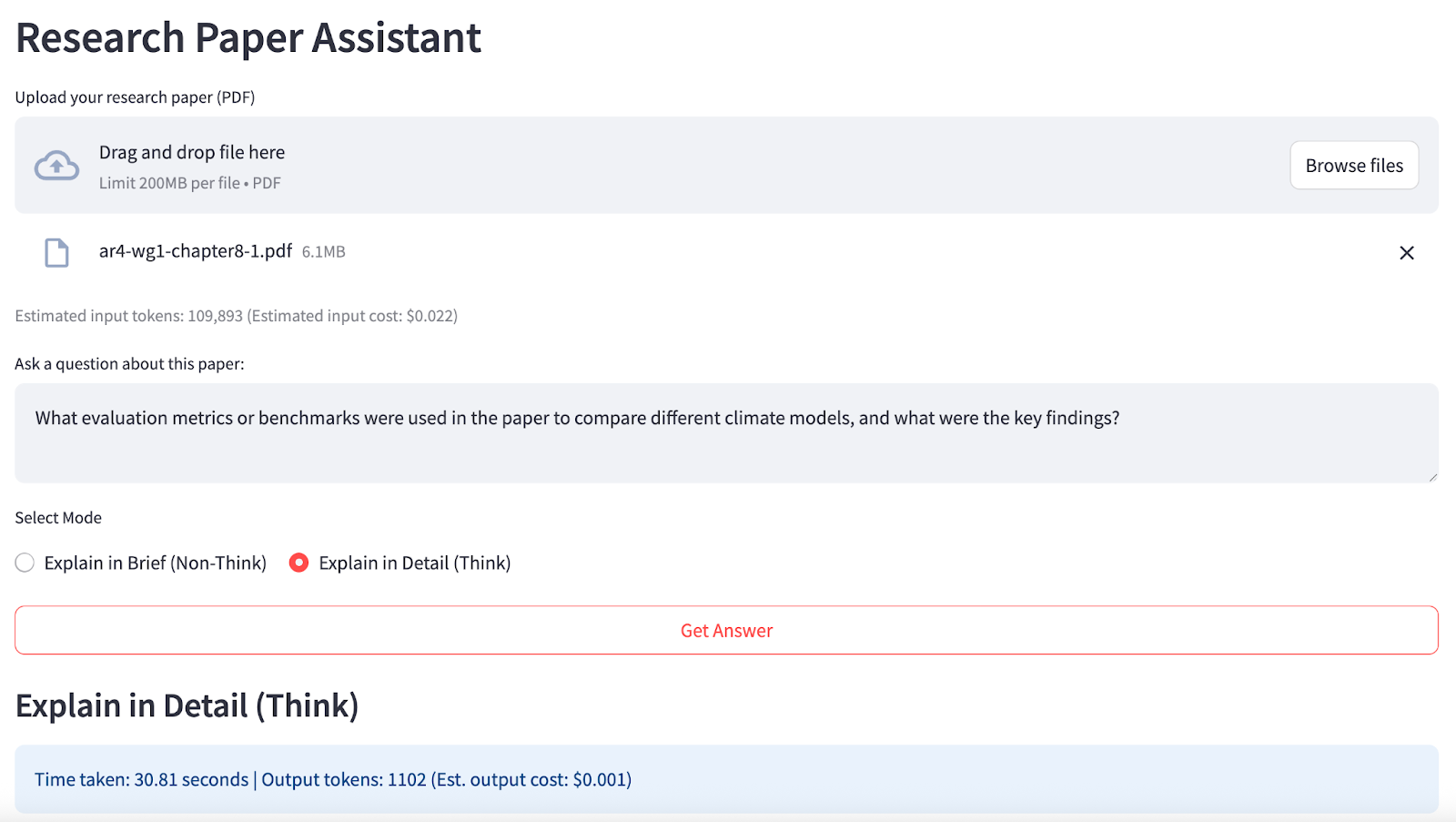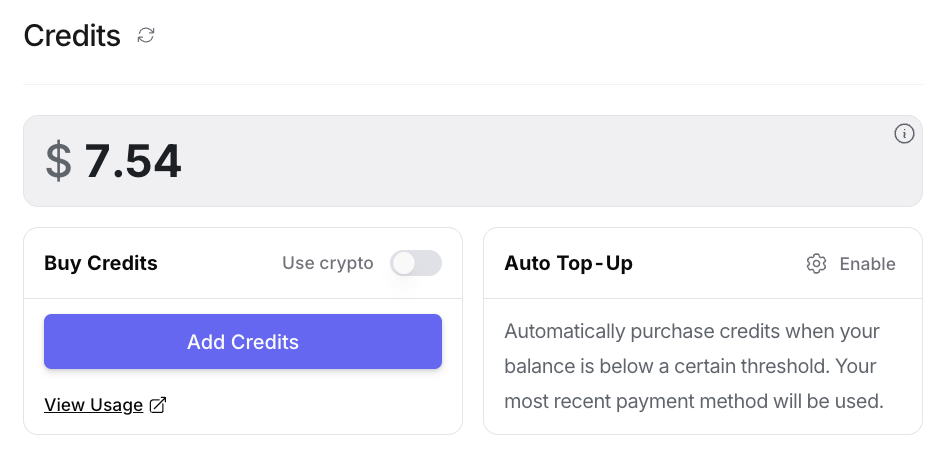Course
DeepSeek recently released DeepSeek V3.1, a large-scale hybrid reasoning model that supports both “think” and “non-think” answer modes, making it ideal for interactive document analysis.
In this blog, I’ll focus on DeepSeek V3.1’s agentic capabilities for understanding research papers. I’ll explain step by step how to turn any PDF into an interactive research assistant through a Streamlit app—I’ll walk you through:
- Integrating DeepSeek V3.1 via OpenRouter’s API for scalable, long-document reasoning
- Extracting and parsing PDF text to handle academic papers of any length
- Designing a Streamlit app that lets users switch between quick factual answers and deep, evidence-based reasoning
- Implementing cost tracking and performance measurement for real-world research scenarios
- Supporting answers with quotes extracted from the source
At the end, your app will look like this:

What Is DeepSeek V3.1?
DeepSeek V3.1 is a 671B-parameter, hybrid Mixture-of-Experts (MoE) model trained for both "thinking" (detailed, reasoned) and "non-thinking" (factual, concise) answering styles. It supports 128,000-token contexts and is accessible via OpenRouter’s OpenAI-compatible API.

Source: DeepSeek
DeepSeek V3.1’s most important features are:
- Long-context handling: DeepSeek V3.1 efficiently processes extremely long documents, supporting context windows up to 128,000 tokens (over 100 pages), making it ideal for comprehensive research papers and reports.
- Dual reasoning modes: The model comes with the following two reasoning modes:
- Thinking mode: This mode delivers detailed, stepwise reasoning and cites evidence directly from the source material for deep analysis and critique.
- Non-thinking mode: This mode provides concise, factual responses for rapid information retrieval and quick Q&A.
- Hybrid mixture-of-experts architecture: DeepSeek V3.1 combines multiple expert subnetworks, enabling both factual recall and advanced synthesis within the same model.
- Agentic and tool-augmented workflows: The model is designed for integration with agent-based systems and supports external tool use for richer, multi-step workflows.
- OpenAI-compatible API access: It is accessible via OpenRouter’s OpenAI-compatible API, making deployment and integration straightforward for developers.
DeepSeek V3.1 Demo: Research Paper Assistant
In this section, I’ll walk through how I used DeepSeek V3.1 to turn any uploaded PDF research paper into an interactive, AI-powered research assistant.
Here’s how it works:
- Upload a PDF research paper and preview the extracted text.
- Ask natural language questions about the paper.
- Choose between “Explain in Brief” (non-think) or “Explain in Detail” (think) response modes.
- Instantly receive answers, along with response time, token usage/cost estimates, and supporting quotes from the source.
Step 1: Prerequisites
Before running this demo, let’s make sure we have all the prerequisites in place.
Step 1.1: Imports
First, ensure you have the following imports installed:
pip install streamlit openai pypdfThis command ensures you have all the core dependencies for UI, PDF handling, and API requests.
Step 1.2: Setting up OpenRouter API key
DeepSeek V3.1 model is available through numerous platforms along with the DeepSeek Official API. However, I used OpenRouter instead, which provides users access to multiple API keys for numerous models and was the most cost-effective for the purpose of this demo. Here are the steps to set up an API Key for DeepSeek V3.1:
- Set up an account at https://openrouter.ai/
- Navigate to the Models tab and search for “DeepSeek V3.1”. You can also choose a base version, but it is trained only for raw next-token prediction, which makes prompting a bit more difficult. So, I used the chat version “deepseek/deepseek-chat-v3.1.”

- Scroll down and click on Create API Key. Fill out the name for the key and credit limit (optional), and click Create. Save this API key for future use.

- Next, navigate to the Credits tab and add your card or bank information. You can also pay via Amazon Pay or crypto. For this demo, I added about $8, which was enough.

Now, set your API key as an environment variable before running the app:
export OPENROUTER_API_KEY=your_api_keyChoosing the Right API
The official DeepSeek API is best suited for high-volume, automated workloads.
For most research, educational, or demo use cases, including this Streamlit Research Paper Assistant, I’d prefer OpenRouter because it is a simpler and more flexible choice. It offers predictable global pricing with no time-window restrictions or cache logic to manage, making it perfect for ad hoc analysis, unique document queries, and easy collaboration.
Note: Using DeepSeek V3.1 through the API requires only around 8 GB of memory for the UI, sparing you from the need to locally host the massive 670B-parameter model, which would otherwise require 170+ GB of disk space and a powerful GPU.
Step 2: Setting Up the Streamlit App
To make DeepSeek V3.1 available through a user-friendly interface, we’ll use Streamlit as our app framework and connect it to the model via OpenRouter’s OpenAI-compatible API.
Step 2.1: Configuration
This step covers environment setup, API authentication, and basic Streamlit configuration.
import streamlit as stimport pypdfimport tempfilefrom openai import OpenAIimport osimport timeimport rest.set_page_config( page_title="DeepSeek V3.1 Research Assistant", layout="wide")with st.sidebar: st.title("Research Paper Assistant") st.info("Tip: Ask about the methods, findings, or reasoning for best results.")OPENROUTER_API_KEY = os.environ.get("OPENROUTER_API_KEY", "")if not OPENROUTER_API_KEY: st.warning("Add your OpenRouter API key to an environment variable.") st.stop()client = OpenAI( base_url="https://openrouter.ai/api/v1", api_key=OPENROUTER_API_KEY,)In the above code, the st.set_page_config() function call customizes the Streamlit app’s page title and layout. The app retrieves the OpenRouter API key from environment variables and an OpenAI-compatible client is instantiated, pointing to the OpenRouter API endpoint, ensuring all subsequent LLM calls are properly routed and authenticated for DeepSeek V3.1.
Step 2.2: Helper functions
Before building the main workflow, we need robust utility functions to handle document processing and resource estimation. In this step, we define helper functions to extract text from uploaded PDFs, preview document content, count the approximate number of tokens, and estimate cost based on OpenRouter’s DeepSeek V3.1 pricing.
def pdf_to_text(uploaded_file): with tempfile.NamedTemporaryFile(delete=False, suffix=".pdf") as tmp_file: tmp_file.write(uploaded_file.read()) tmp_path = tmp_file.name reader = pypdf.PdfReader(tmp_path) text = "" for page in reader.pages: page_text = page.extract_text() if page_text: text += page_text + "\n" return textdef preview_pdf_text(text, max_chars=600): preview = text[:max_chars] if len(text) > max_chars: preview += "\n...\n[Preview truncated]" return previewdef count_tokens(text): return max(1, int(len(text) / 4))def estimate_cost(tokens, mode="input"): if mode == "input": return tokens / 1_000_000 * 0.20 else: return tokens / 1_000_000 * 0.80With these helper functions implemented, our backend is well-prepared to support a scalable research assistant interface:
- Efficient PDF parsing: The
pdf_to_text()function processes multi-page PDFs into plain text while preserving page boundaries, making the data suitable for LLM input and further downstream processing. - Token counting and cost estimation: The
count_tokens()function provides an approximate token count to help monitor API usage relative to DeepSeek’s high context window. While theestimate_cost()function then translates these token counts into real-time cost feedback using OpenRouter’s pricing for input and output, keeping the user informed about the computational budget for each query. - Preview generation: The
preview_pdf_text()function creates truncated previews, allowing users to verify the integrity and relevance of the extracted content before incurring model costs or hitting API limits.
With these building blocks in place, we can now move on to assembling the complete Streamlit app for long-context, agentic research paper Q&A.
Step 2.3: Streamlit application
With the core utilities in place, we can now assemble the main Streamlit user interface that brings together PDF processing, token/cost estimation, user-driven Q&A, and live interaction with DeepSeek V3.1 via OpenRouter.
st.header("Research Paper Assistant")pdf_file = st.file_uploader("Upload your research paper (PDF)", type=["pdf"])if "paper_text" not in st.session_state or st.session_state.get("last_uploaded") != pdf_file: if pdf_file is not None: with st.spinner("Extracting text from PDF..."): st.session_state.paper_text = pdf_to_text(pdf_file) st.session_state.last_uploaded = pdf_file st.success(f"PDF uploaded. Total characters extracted: {len(st.session_state.paper_text):,}") with st.expander("Preview of extracted PDF text:"): st.code(preview_pdf_text(st.session_state.paper_text), language='markdown')paper_text = st.session_state.get("paper_text")if paper_text: input_tokens = count_tokens(paper_text) st.caption(f"Estimated input tokens: {input_tokens:,} (Estimated input cost: ${estimate_cost(input_tokens):.3f})") question = st.text_area("Ask a question about this paper:", height=80, placeholder="E.g. What are the main findings?") mode = st.radio( "Select Mode", ["Explain in Brief (Non-Think)", "Explain in Detail (Think)"], horizontal=True, ) go = st.button("Get Answer", use_container_width=True) if question and go: if mode == "Explain in Brief (Non-Think)": prompt = ( f"{paper_text}\n\n" f"Question: {question}\n" "First, answer in a few sentences. Then, quote 1–2 exact sentences from the above paper that best support your answer. " "Show each quote on a new line." ) thinking_flag = False header = "Explain in Brief (Non-Think)" else: prompt = ( f"{paper_text}\n\n" f"Question: {question}\n" "First, answer in detail with reasoning and evidence. Then, quote 2–3 exact sentences from the above paper that most strongly support your answer. " "List the quotes after your answer." ) thinking_flag = True header = "Explain in Detail (Think)" with st.spinner(f"Generating answer..."): start_time = time.perf_counter() try: response = client.chat.completions.create( model="deepseek/deepseek-chat-v3.1", messages=[ {"role": "system", "content": "You are a helpful research assistant."}, {"role": "user", "content": prompt} ], max_tokens=900, extra_body={"thinking": thinking_flag}, ) answer = response.choices[0].message.content.strip() output_tokens = count_tokens(answer) except Exception as e: answer = f"Error: {e}" output_tokens = 0 end_time = time.perf_counter() elapsed_time = end_time - start_time parts = re.split(r"(?:^|\n)(Quotes?:?)", answer, flags=re.IGNORECASE) if len(parts) >= 3: main_answer = parts[0].strip() quotes = parts[2].strip() else: main_answer = answer quotes = None st.markdown(f"### {header}") st.info(f"Time taken: {elapsed_time:.2f} seconds | Output tokens: {output_tokens} (Est. output cost: ${estimate_cost(output_tokens, 'output'):.3f})") st.write(main_answer) if quotes: st.markdown("**Supporting Quotes:**") st.success(quotes)This Streamlit application implements a dynamic research paper assistant using DeepSeek V3.1, handling everything from document ingestion to context-aware LLM Q&A. Here are the key functions handled by the StreamLit application:
1. PDF upload and caching
The user uploads a PDF file through the interface, then:
- The app checks
st.session_stateto see if the file is new. If so, it extracts the text and caches it insession_statealong with the upload reference, avoiding repeated extraction on every interaction. - After extraction, it previews the first ~600 characters of the document, along with stats like character count, estimated input tokens, and cost.
2. User query and mode selection
Once a document is loaded, the user can type a question and select between Non-think and Think mode, where the UI adapts the prompt instructions for each mode:
- Non-think mode: This mode returns a brief answer with 1–2 supporting quotes from the paper.
- Think mode: This mode returns a detailed, evidence-backed answer with 2–3 supporting quotes.
3. Prompt engineering and API call
When the user clicks "Get Answer," then the app:
- Builds a context-rich prompt, injecting the paper content, question, and answer instructions.
- Sets the
thinkingparameter in the OpenRouter API request (extra_body={"thinking": thinking_flag}), ensuring the model runs in the correct reasoning mode, rather than relying on temperature. - The app measures inference time, output token count, and cost for each response, displaying these for transparency.
4. Postprocessing and display
The returned answer is parsed such that the main response and supporting quotes are split (if found). Then, both the answer and the extracted quotes are rendered in the UI, highlighting the precise textual evidence from the source paper.
To try it yourself, save the code as app.py and launch:
streamlit run app.pyIn my experiments, DeepSeek V3.1 took much longer to generate detailed “think” answers compared to brief “non-think” responses. This is because longer and more reasoned outputs require more computation and time.
Conclusion
This tutorial demonstrated how we can use DeepSeek V3.1 to build an interactive research paper assistant capable of analyzing long documents, delivering both concise and detailed answers, and tracking costs in real-time—all within a Streamlit app. If you're keen to keep building projects with DeepSeek, I recommend checking out our tutorial covering the new DeepSeek V3.2-Speciale.

I am a Google Developers Expert in ML(Gen AI), a Kaggle 3x Expert, and a Women Techmakers Ambassador with 3+ years of experience in tech. I co-founded a health-tech startup in 2020 and am pursuing a master's in computer science at Georgia Tech, specializing in machine learning.